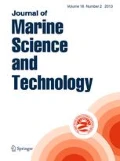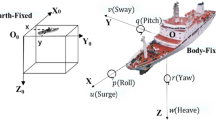Abstract
Nowadays, there is a growing expectation to promote operational efficiency of ship fleets in maritime transportation. This study presents a methodical approach basis on statistical learning to model ship performance monitoring problem. It takes the advantage of shrinkage models such as Ridge and Lasso. The demonstrations are conducted through numerical operational features (i.e., fuel consumption, speed, trim, draft, heeling, headwind, etc.) via train and test data set recorded from 2-h voyages of a ferry ship in 2-month period. The findings address to consider trim, pitch, and wind effect. Besides feature selections, both models, which are capable of predicting overall accuracy, learn the relationship between features from the original data set. Comparing to current nonlinear models applied to ship operational performance problems, the Ridge and the Lasso models enable to minimize complexity and to enhance interpretability. Consequently, this study is capable of increasing situational awareness of ship operators (Master and Chief Engineer) and shore-based organizations for monitoring of ship performance. A promising future research may conduct interface designs to transform the continuously monitored features into control actions in terms of ship operational performance management concept.









Similar content being viewed by others
References
Ng MM, Lun YV, Lai KH, Cheng TCE (2013) Research on shipping studies. Int J Shipp Transport Logist 5(1):1–12
Kim JG, Kim HJ, Lee PTW (2013) Optimising containership speed and fleet size under a carbon tax and an emission trading scheme. Int J Shipp Transport Logist 5(6):571–590
Koss L (1996) Technology development for environmentally sound ships of the 21st century: an international perspective. J Mar Sci Technol 1(3):127–137
IMO (2009) Guidance for the development of a ship energy efficiency management plan (SEEMP). MEPC.1/Circ. 683, 17/08/2009
IMO (2012) Guidelines on the method of calculation of the attained energy efficiency design index (EEDI) for new ship, annex 8 resolution MEPC.212 (63), 2/03/2012
IMO (2012) Guideline for the development of a ship energy efficiency management plan (SEEMP), annex 9 resolution MEPC.213 (63), 2/03/2012
IMO (2012) Guideline on survey and certification of the energy efficiency design index (EEDI), annex 10 resolution MEPC.214 (63), 02/03/2012
IMO (2009) Guidelines for voluntary use of the ship energy efficiency operational indicator (EEOI) MEPC. 1/Circ 684, 17/08/2009
European Commission (EC) (2013) Proposal for a regulation of the European Parliament and of the Council on the monitoring, reporting and verification of carbon dioxide emissions from maritime transport and amending Regulation (EU) No 525/2013. COM(2013) 480 final
Aldous L, Smith T, Bucknall R, Thompson P (2015) Uncertainty analysis in ship performance monitoring. Ocean Eng 110:29–38
Buhaug O, Corbett JJ, Endersen O, Eyring V, Faber J, Hanayama S, Lee DS, Lee D, Lindstad H, Markowska AZ, Mjelde A, Nilsen J, Palsson C, Winebrake JJ, Wu W, Yoshida K (2009) Second IMO GHG study 2009. Technical reports, International Maritime Organization (IMO)
Lai KH, Lun YV, Wong CW, Cheng TCE (2013) Measures for evaluating green shipping practices implementation. Int J Shipp Transport Logist 5(2):217–235
Hansen A (2010) Monitoring of hull condition of ships. PhD diss., MSc Thesis Norwegian University of Science and Technology
Orihara H, Tsujimoto M (2017) Performance prediction of full-scale ship and analysis by means of on-board monitoring. Part 2: Validation of full-scale performance predictions in actual seas. J Mar Sci Technol 1–20
Petersen JP, Jacobsen DJ, Winther O (2012) Statistical modelling for ship propulsion efficiency. J Mar Sci Technol 17(1):30–39
Telfer EV (1927) The practical analysis of merchant ship trials and service performance. North East Coast Institution of Engineers and Shipbuilders, Newcastle-upon-Tyne
Hasselaar TWF (2011) An investigation into the development of an advanced ship performance monitoring and analysis system (Doctoral dissertation, University of Newcastle Upon Tyne)
Choi JE, Kim JH, Lee HG, Choi BJ, Lee DH (2009) Computational predictions of ship-speed performance. J Mar Sci Technol 14(3):322–333
Lu R, Turan O, Boulougouris E, Banks C, Incecik A (2015) A semi-empirical ship operational performance prediction model for voyage optimization towards energy efficient shipping. Ocean Eng 110:18–28
Lepore A, Reis MS, Palumbo B, Rendall R, Capezza C (2017) A comparison of advanced regression techniques for predicting ship CO2 emissions. Qual Reliabil Eng Int 33(6):1281–1292
Leifsson L, Sævarsdóttir H, Sigurðsson S, Vésteinsson A (2008) Grey-box modeling of an ocean vessel for operational optimization. Simul Model Pract Theory 16(8):923–932
Schrady DA, Smyth GK, Vassian RB (1996) Predicting ship fuel consumption: update. Naval Postgraduate School, Monterey
ITTC (2002) The specialist committee on speed and powering trials. In: Proceedings of the 23rd ITTC, vol II, pp 341–367
Van Manen JD, Van Ossanen P, Lewis EV (1988) Principles of naval architecture, second revision, volume II: resistance, propulsion, and vibration. Society of Naval Architects and Marine Engineers, Jersey
Kandasamy M, Ooi SK, Carrica P, Stern F, Campana EF, Peri D, de Waal N (2011) CFD validation studies for a high-speed foil-assisted semi-planing catamaran. J Mar Sci Technol 16(2):157–167
Sato Y, Miyata H, Sato T (1999) CFD simulation of 3-dimensional motion of a ship in waves: application to an advancing ship in regular heading waves. J Mar Sci Technol 4(3):108–116
Viola IM, Bartesaghi S, Della Rosa S, Cutolo S (2013) On the use of CFD for the design of yacht hulls. Trans R Inst Nav Archit Part B Int J Small Craft Technol 155(2):81–93
Bocchetti D, Lepore A, Palumbo B, Vitiello L (2013) A statistical control of the ship fuel consumption. In: Proceedings, international conference on the design, construction and operation of passenger ships, royal institution of naval architects, November, pp 20–21
Coraddu A, Oneto L, Baldi F, Anguita D (2017) Vessels fuel consumption forecast and trim optimisation: a data analytics perspective. Ocean Eng 130:351–370
El Noshokaty S (2013) Shipping optimisation systems (SOS): liner optimisation perspective. Int J Shipp Transport Logist 5(3):237–256
Logan KP, Reid RE, Williams VE (1980) Considerations in establishing a speed performance monitoring system for merchant ships: part I: techniques based on statistical methods. In: Proceedings, international symposium shipboard energy conservation’80
Pedersen BP, Larsen J (2009) Prediction of full-scale propulsion power using artificial neural networks. In: Proceedings of the 8th international conference on computer and IT applications in the maritime industries (COMPIT’09), Budapest, Hungary May, pp 337–350
Petersen JP, Winther O, Jacobsen DJ (2012) A machine-learning approach to predict main energy consumption under realistic operational conditions. Ship Technol Res 59(1):64–72
Mak L, Sullivan M, Kuczora A, Millan J (2014) Ship performance monitoring and analysis to improve fuel efficiency. In: Oceans-St. John’s, 2014, pp 1–10. IEEE
Perera LP (2016) Marine engine centered localized models for sensor fault detection under ship performance monitoring. IFAC-PapersOnLine 49(28):91–96
Perera LP, Mo B (2016) Marine engine operating regions under principal component analysis to evaluate ship performance and navigation behavior. IFAC-PapersOnLine 49(23):512–517
Perera LP, Mo B (2017) Visual analytics in ship performance and navigation information for sensor specific fault detection. In: ASME 2017 36th international conference on ocean, offshore and arctic engineering. American Society of Mechanical Engineers, pp V07BT06A032–V07BT06A032
Petersen JP (2011) Mining of ship operation data for energy conservation (Doctoral dissertation, Technical University of Denmark (DTU))
Propulsion modelling (2017) http://cogsys.imm.dtu.dk/propulsionmodelling/data.html. Accessed 4 Dec 2017
James G, Witten D, Hastie T, Tibshirani R (2013) An introduction to statistical learning, vol 112. Springer, New York
Brasiello A, Adiletta G, Russo P, Crescitelli S, Albanese D, Di Matteo M (2013) Mathematical modeling of eggplant drying: shrinkage effect. J Food Eng 114(1):99–105
Puppala AJ, Manosuthikij T, Chittoori BC (2014) Swell and shrinkage strain prediction models for expansive clays. Eng Geol 168:1–8
Pereira JM, Basto M, da Silva AF (2016) The logistic lasso and ridge regression in predicting corporate failure. Proc Econ Finance 39:634–641
Tommasi D, Wolf A (2018) Estimating household resource shares: a shrinkage approach. Econ Lett 163:75–78
Dong YW, Li XL, Zhao Q, Yang J, Dao M (2017) Modeling of shrinkage during investment casting of thin-walled hollow turbine blades. J Mater Process Technol 244:190–203
Hoerl AE, Kennard RW (1970) Ridge regression: applications to nonorthogonal problems. Technometrics 12(1):69–82
Tibshirani R (1996) Regression shrinkage and selection via the lasso. J R Stat Soc Series B:267–288 (Methodological)
Cule E, De Iorio M (2012) A semi-automatic method to guide the choice of ridge parameter in ridge regression. arXiv preprint arXiv:1205.0686
Hastie T, Tibshirani R, Friedman J (2009) The elements of statistical learning: data mining, inference, and prediction. 2nd edn. Springer, New York
Abouelfadl AH, Abdelraouf EEY (2016) The impact of optimizing trim on reducing fuel consumption. J Shipp Ocean Eng 6:179–184
Acknowledgements
This article is produced from a PhD thesis research entitled “Proposing an Operational Data Analytics Approach in Ship Management” which has been executed in a PhD Program in Maritime Transportation Engineering of Istanbul Technical University Graduate School of Science, Engineering and Technology.
Author information
Authors and Affiliations
Corresponding author
About this article
Cite this article
Soner, O., Akyuz, E. & Celik, M. Statistical modelling of ship operational performance monitoring problem. J Mar Sci Technol 24, 543–552 (2019). https://doi.org/10.1007/s00773-018-0574-y
Received:
Accepted:
Published:
Issue Date:
DOI: https://doi.org/10.1007/s00773-018-0574-y




